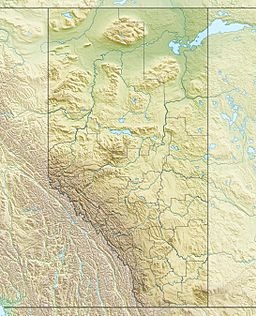Pulpit Peak facts for kids
Quick facts for kids Pulpit Peak |
|
|---|---|

Pulpit Peak & N. Shoulder from Icefields Parkway
|
|
| Highest point | |
| Elevation | 2,720 m (8,920 ft) |
| Prominence | 140 m (460 ft) |
| Parent peak | Lilliput Mountain (2925 m) |
| Listing | Mountains of Alberta |
| Geography | |
| Location | Banff National Park Alberta, Canada |
| Parent range | Waputik Range Canadian Rockies |
| Topo map | NTS 82N09 |
| Geology | |
| Age of rock | Cambrian |
| Type of rock | Sedimentary |
| Climbing | |
| Easiest route | Scramble |
Pulpit Peak is a 2,720-metre (8,920-foot) mountain summit located one km south of Hector Lake in Banff National Park, in the Canadian Rockies of Alberta, Canada. Its nearest higher peak is Lilliput Mountain, 3.6 km (2.2 mi) to the southwest. Pulpit Peak is situated east of the Waputik Icefield, and is a member of the Waputik Mountains. Pulpit Peak can be seen from the Icefields Parkway towering 900 metres (2,950 ft) above Hector Lake.
History
Pulpit Peak was named in 1898 by Charles Sproull Thompson (1869-1921), who participated in numerous first ascents in the Canadian Rockies. He believed the peak resembled a pulpit in a church. The mountain's name was officially adopted in 1924 by the Geographical Names Board of Canada.
Geology
Like other mountains in Banff Park, Pulpit Peak is composed of sedimentary rock laid down during the Precambrian to Jurassic periods. Formed in shallow seas, this sedimentary rock was pushed east and over the top of younger rock during the Laramide orogeny.
Climate
Based on the Köppen climate classification, Pulpit Peak is located in a subarctic climate zone with cold, snowy winters, and mild summers. Temperatures can drop below -20 °C with wind chill factors below -30 °C. Precipitation runoff from Pulpit Peak drains into the Bow River which is a tributary of the Saskatchewan River.



